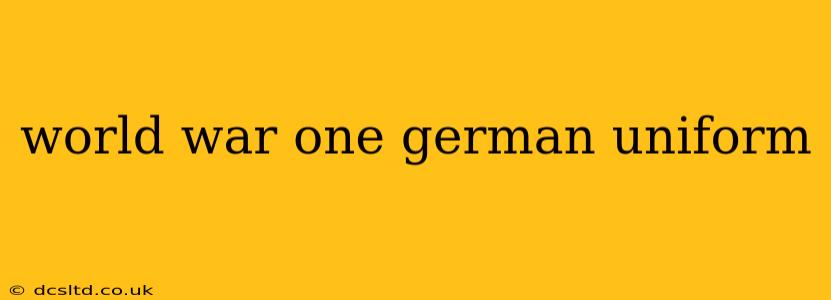World War One saw a vast array of German military uniforms, reflecting the diverse branches of service, ranks, and even regional variations. Understanding these uniforms provides a fascinating glimpse into the organization and culture of the German army during this pivotal conflict. This guide explores the key features and variations of German World War One uniforms, answering common questions about their design, evolution, and significance.
What were the main features of a German World War One uniform?
The standard German infantry uniform of World War One was characterized by its practicality and relative simplicity. Key features included:
-
Tunic: A relatively long-tailed tunic, typically dark grey or field grey (depending on the period and branch), with various pockets and buttons. The design evolved throughout the war, with earlier versions featuring more elaborate details than the later, more utilitarian designs.
-
Trousers: Dark grey or field grey trousers, often with reinforced knees for durability. These were generally loose-fitting for comfort and ease of movement.
-
Headgear: The iconic Pickelhaube (pointed helmet) was the standard headgear for much of the early war, though its use gradually decreased as the war progressed. Stahlhelm (steel helmet) gradually replaced the Pickelhaube, providing better protection. Different branches of service often had variations in their headgear.
-
Boots: Sturdy leather boots were essential, providing protection and support for soldiers engaged in prolonged periods of marching and fighting in trenches.
-
Equipment: Uniforms were often adorned with various pieces of equipment, including pouches for ammunition, water bottles, and entrenching tools. The specific equipment varied based on the soldier's role and branch of service.
What different types of German World War One uniforms existed?
Beyond the standard infantry uniform, the German army utilized a diverse range of uniforms catering to different roles and branches. Key variations included:
-
Officer Uniforms: Officer uniforms featured more elaborate details and higher-quality materials than enlisted men's uniforms. They often included more elaborate braid, insignia, and other distinguishing features reflecting their rank.
-
Artillery, Cavalry, and other Branches: Different branches of service (artillery, cavalry, engineers, etc.) had distinctive uniform features, often reflecting their specific roles and operational needs. For example, cavalry uniforms frequently incorporated different types of headgear and more elaborate embellishments.
-
Colonial Troops: Germany's colonial troops wore uniforms adapted to the climates and conditions of their respective deployment locations. These often featured lighter materials and different styles of headgear to better suit the environment.
-
Luftstreitkräfte (Air Force): The German air service, relatively new during WWI, had uniforms that combined elements of army and naval styles, reflecting their dual responsibilities.
How did German uniforms change throughout World War One?
The design and composition of German uniforms evolved throughout the war, largely in response to practical considerations on the battlefield. Key changes included:
-
Shift to Field Grey: The early war's dark grey uniforms were gradually replaced with field grey, offering better camouflage in the trenches and on the battlefield.
-
Simplification of Design: As the war progressed, the designs of uniforms became simpler, with less elaborate details and ornamentation to save resources and streamline production.
-
Increased Use of Steel Helmets: The Stahlhelm gradually replaced the Pickelhaube due to its superior protection against shrapnel and other battlefield hazards.
-
Regional Variations: While a standardized design was enforced, minor regional variations in uniform details sometimes persisted.
How can I tell the difference between a genuine World War One German uniform and a reproduction?
Distinguishing genuine World War One German uniforms from reproductions requires careful examination and expertise. Key factors to consider include:
-
Materials: Authentic uniforms generally used materials consistent with the era, and often show signs of age and wear.
-
Construction: The craftsmanship and stitching of original uniforms were usually more refined than reproductions.
-
Insignia and Buttons: Original insignia and buttons are often marked with makers' marks or other identifying features that can help authenticate them.
-
Provenance: A documented history of ownership and provenance can significantly increase the credibility of a uniform's authenticity. This often involves extensive research and verification.
What are some common mistakes people make when identifying World War One German uniforms?
A common mistake is relying solely on visual similarities to identify a uniform's authenticity. Detailed examination of materials, construction, and markings is crucial. Another pitfall is overlooking the significant variations among different branches and periods during the war. Finally, misinformation spread online and in less reliable sources can lead to inaccurate identification. Always consult reputable sources and experts for accurate identification.
This comprehensive overview provides a solid foundation for understanding the fascinating world of World War One German uniforms. Their study offers a tangible connection to the realities of this pivotal conflict, highlighting the challenges, adaptations, and ultimately, the human experience of war. Remember to consult reputable historical resources for further in-depth study.
